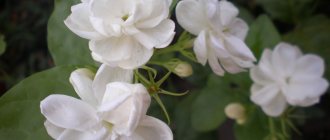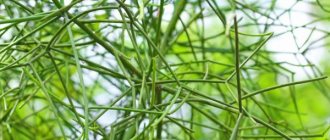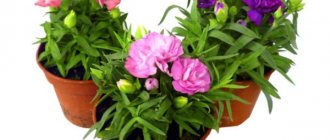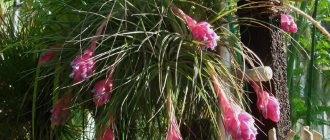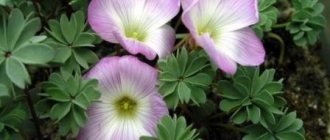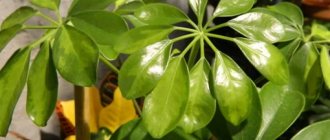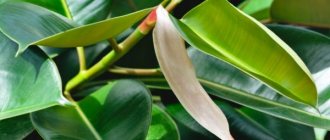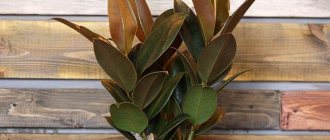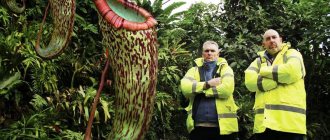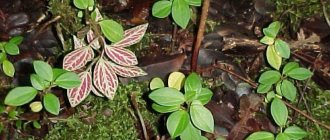Botanical description of the plant
The natural habitat of Wood's Ceropegia is extensive and includes:
- southern Africa;
- northern Australia;
- India;
- China;
- Canary Islands.
Ceropegia Wooda is a liana-shaped perennial succulent that belongs to the Lastovnevye family. The rhizome is tuberous. Thin, heart-shaped leaf plates are located opposite on long, thin shoots. The outer surface of the leaves has a marbled silver pattern, the lower surface is purple.
Did you know? Under natural conditions, most ceropegia emit an unpleasant putrefactive aroma during flowering in order to attract flies for pollination. When cultivated at home, this smell is almost not noticeable, except perhaps if you stick your nose directly into the flower.
Small tuberous growths form in the axils of old leaf blades, which play a role in accumulating and retaining moisture. The plant can go without water for a long time, even in drought, thanks to these growths and tuberous thickenings of the roots. The stems look like threads dotted with leaf hearts. They are intertwined and colored purple. Even with home cultivation, the stems can reach a length of 2.5–3 m.
The growth of vines is very high - over the summer it can be up to 1 m. Flowering begins in the spring, around April, and lasts until September inclusive. Flowers are formed in the leaf axils. They are painted in a light purple color and have an unusual shape, reminiscent of a candelabra. Wood's Ceropegia is distinguished by its high growth vigor and endurance. It adapts perfectly to any conditions, rarely gets sick and is affected by pests.
Types and varieties
Four types of Ceropegia are most often grown in indoor culture.
African Ceropegia africana
An herbaceous perennial with fleshy creeping shoots, small, smooth, thickened ovate or linear leaves and small dark purple or green flowers with a corolla tube up to 2 cm long and petals with converging tips.
In the photo: Ceropegia woodii
Ceropegia barklyi
Also an herbaceous perennial with a rounded, slightly branched tuberous rhizome, fleshy, usually bare, but sometimes pubescent shoots and light green ovate-lanceolate leaves with whitish veins, 2.5 to 5 cm long, sitting on short petioles. The flowers of this ceropegia, green on the outside and purple on the inside, reach a length of 5 cm and are collected in umbrellas. Their fibrous petals, triangular at the base, are pointed towards the apex.
How to grow another beautiful vine - hoya
Ceropegia woodii
It has a gray tuberous rhizome and creeping purple shoots, on which there are ovoid, lanceolate or triangular fleshy leaves up to 2 cm long and up to 1.5 cm wide, with a marbled pattern on a dark green background on top, and purple or light green underneath. During the period of active growth, aerial nodules of light yellow color are formed in the shoot nodes, which, under conditions of high humidity, develop roots and are used for plant propagation. In the axils of the leaves, small flowers with a pale flesh-colored corolla and dark brown petals, pubescent with light hair on the inside, are formed.
Under good maintenance conditions, the plant can bloom profusely throughout the year, while caring for Wood's Ceropegia is no more difficult than caring for any other plant of this genus.
In the photo: Ceropegia woodii
Sanderson's Ceropegia sandersonii
It is also a perennial with thin creeping shoots, fleshy heart-ovate, obtuse or briefly pointed leaves at the apex up to 5 cm long and up to 4 cm wide, in which the midrib protrudes convexly from below. The inflorescence of this species of ceropegia is short and has few flowers. Reaching a length of 7 cm, the green corolla in the throat area is colored in a lighter tone. The corolla tube is funnel-shaped at the top and slightly swollen at the base. Five subulate, expanding petals form a parachute-shaped dome, and whitish hairs grow along their edges.
In the photo: Ceropegia sandersonii
Ceropegia stapeliiformis
This is a creeping plant with thick shoots, rounded at the bottom, up to 2 cm thick, which become three-ridged towards the top. Three small leaves with two stipules are arranged whorled on each reduced node. At the top, the leaves become thin and curl around the support. The flowers are collected in a few-flowered inflorescence. Their corolla is 5-7 cm long, the corolla tube is funnel-shaped at the top and swollen at the base. The flowers have five petals, they are arched and painted white on the outside with dark brown spots.
In the photo: Ceropegia stapeliiformis
In addition to the described species, Ceropegia variegata is grown at home - a hybrid form that is similar to the producing species, but is still very different from it. Experiments with the development of new forms and hybrids of Ceropegia continue to this day.
Optimal conditions for growth
Hardy Wood's ceropegia are not at all whimsical in terms of microclimate.
Lighting
In the presence of high-quality illumination, flowering of Ceropegia Wood can continue almost all year round. She is not afraid of short-term contact with direct sunlight. It is better to place plants on the east or west side of the room.
Important! The brighter the diffused lighting, the higher the decorative effect of the leaves - the pattern on the outside becomes brighter. But prolonged contact with the open sun can lead to burns.
Ventilation
In summer, it is better to move plants to the balcony. In winter, ventilation must be carried out, but drafts must be avoided.
Temperature
Ceropegia is not at all demanding on temperature conditions and tolerates temperature changes from +10°C to +27°C. But in order to achieve year-round flowering, it is better to maintain a constant temperature within +20...+23°C.
Air humidity
Air humidity can be any. Additional moistening of the space around the plant and spraying are not required even during the driest periods.
Find out how to properly plant indoor flowers in a pot.
Diseases and pests
- The plant gets sick mainly due to improper care. With poor drainage, water stagnates, causing the rhizome to rot. The same thing happens when you water too often. Ceropegia loses its leaves and stops blooming. It will not be possible to save such a plant; it must be preserved by rooting cuttings, choosing them from the least damaged stems.
- With insufficient lighting, the plant becomes pale, the leaves curl, and there are almost (or no) flowers. This can be easily corrected by correctly positioning the plant towards the light source or adjusting the lighting in winter. The reddish tint of the plant and burns on the leaves indicate the other extreme - excessive exposure to sunlight, simply put, sunburn.
The lack of moisture will be indicated by thinning leaves and slower growth. But do not immediately fill the container with the plant with a large amount of water. Pour water little by little, you can add fertilizer to speed up the recovery of the plant.
- Ceropegia is extremely rarely affected by pests; many of its species have poisonous juice and are not attractive to sucking pests. But if you do notice a spider mite or a cluster of mealybugs, wash them off with soapy water, carefully, avoiding getting them on the soil. If you get a completely abandoned plant (this happens both when you buy it in a store or from friends), and there are enough pests, use insecticides for indoor plants a lot, carefully studying the instructions for use.
- With proper care, which is very simple, this exotic, modest beauty will delight you all year round. This plant is also very convenient for the office, as it does not require complex care. For example, Wood's ceropegia, when placed in an ampelous arrangement, with its leaves reminiscent of hearts or coins, and flowers resembling holiday candles, is quite suitable even in the most respectable offices. And Ceropegia stapeliformes can be located in the employee’s break room to amuse them a little.
If you keep plants at home, find a place for them to be kept away from pets (if you have any). The plant's poisonous sap can harm your pet, and pets can rummage through wide pots and damage the plants.
Home care
It is difficult to find a more grateful plant than Ceropegia. Even with minimal care, it blooms profusely until autumn.
Watering
You will not need to water this plant often. There is no specific watering schedule - you need to focus on soil moisture. Water is added when the top layer of soil dries 1 cm deep. In summer, watering is carried out approximately once a week, but it can be more often if the air temperature rises above +27°C. In winter, watering should be reduced to a minimum - 1-2 times a month.
It is best to water from the top. Water is poured along the edge of the pot, being careful not to get it on the shoots and leaves. Any liquid that has drained into the pan must be removed immediately. Do not allow the soil to become waterlogged, otherwise the roots may rot. Water for irrigation should be at room temperature. Settled tap water is suitable. It is better not to use boiled water - it contains traces of salts and scale, which can damage the plant.
Top dressing
Fertilizers are applied once a month during the active growing season; in winter they are excluded. As a top dressing, you can use complex preparations intended for cacti, succulents and orchids. The fertilizers “Stimovit for cacti and succulents” and “Stimovit for orchids” have proven themselves well. They are diluted according to the instructions and applied at the root.
Also read about how to feed Decembrist at home for flowering.
Trimming
Ceropegia does not require mandatory pruning. It is carried out if there is a need to shorten shoots that are too elongated, or when a plant needs to be propagated. Shoots play an important role in feeding the plant and storing moisture, so excessive pruning can lead to drying out.
Transfer
Transplantation is carried out in March - April annually until the plant reaches three years of age. Subsequently, transplantation is carried out every 2 years.
Transplantation is carried out using the transshipment method. Pots are selected small in height and wide. The new container should be 1 finger larger in diameter and height than the previous one. The main requirement is a large number of drainage holes. It is better to mix the soil yourself.
To do this, connect:
- 5 parts leaf-turf soil;
- 2 parts of plant humus;
- 1 part peat;
- 1 part sand.
To increase the looseness of the soil, add 20% perlite and 10% sphagnum moss to the resulting composition. The earth is disinfected with a solution of wood ash: for this, add 1 tbsp to 2 liters of water. l. ashes. The liquid is mixed and brought to a boil, poured immediately hot into the soil and stirred thoroughly. The pots are disinfected using a manganese solution: add 2 g of the substance to 1 liter of water. The day before transplantation, watering is carried out, but not too much.
Important! every 5 years
.
This means that 5-year-old specimens are not replanted, but several cuttings are separated and rooted. Expanded clay mixed with foam shavings or perlite is placed in new containers. Drainage should occupy 1/4 of the pot. Then lay 1 cm of soil. The plant is removed from the old container and the roots are examined: if everything is fine, it is moved to a new container. The voids are filled with soil, the surface of the soil around the stems is slightly compacted.
The transplanted plant is left for 5 days in a place where there is high-quality protection from direct sunlight. After this time, you can move the ceropegia to a permanent place and, if necessary, lightly moisten the soil surface.
Flower care
Proper planting and care of tigridia in open ground
One type of succulent that can be grown indoors is Ceropegia. Caring for a plant at home is quite simple, but you should follow a few basic rules:
- The plant should be watered in a timely manner with a moderate amount of clean water.
- After five years, the plant needs to be renewed, as the old shoots become long, lethargic and lose many leaves.
- Using a support is also an important step in growing the plant, as the flower's stems often become tangled as they grow.
- The temperature in the room should be from twenty to twenty-five degrees, since in the wild ceropegia grows in hot countries. In winter, you can lower the temperature to fifteen degrees, but under such conditions the stems of ceropegia will develop more slowly.
Soil and fertilizing
A flower like Ceropegia is best grown in loose soil with the addition of inorganic elements.
In order to prepare the land for cultivation, it is necessary to mix turf and leaf soil, humus, coarse sand and charcoal. This mixture will help prevent the occurrence of a number of diseases and root rot. Land for planting seedlings can also be purchased at a specialized store. When planting a plant, it is better to use a pot that has a wide hole at the bottom so that excess liquid does not accumulate in the soil.
To prevent the flower from dying, it must be fed in summer and spring; in other periods, feeding is not required.
The flower is practically not susceptible to disease, but the formation of root rot is possible. The disease can occur due to too wet or heavy soil. Rot may also be accompanied by weakened stems and yellowed leaves.
If the leaves of ceropegia begin to curl, and the shoots stretch out and become thin, then the plant must be placed in a more illuminated place. With too much light, the leaves may take on a reddish or ruby hue.
Transplantation and propagation
Ceropegia reproduces in several ways:
- By cuttings. When propagating in this way, the cuttings must be dried and pinned to the ground with the nodes down. The plant should be placed in a warm and well-lit place. In order to stimulate growth, it can be covered with film, thereby creating a greenhouse effect.
- You can grow a flower from a seed, but it is almost impossible to find it in the store.
- Root division.
Young ceropegia is replanted every year, but does not require routine pruning. To stimulate branching, you can pinch the flower stem. A plant that is older than three years does not require annual replanting; such flowers can be planted in a new pot after two years.
Reproduction methods
Wood's ceropegia can be propagated at home in several ways:
- seeds;
- cuttings;
- division.
Propagation by seeds
Seed material is planted in the spring. The substrate for planting should be light and loose. At this stage, you can use a mixture of sand and peat, adding a little leaf humus - about 20% of the total volume of the mixture. The mixture can be disinfected in the oven at a temperature of +100°C. After disinfection, the soil must be moistened; its structure should be quite loose, but not waterlogged.
Did you know? Succulent plants are very popular due to their ability to maintain freshness for a long time. Recently, a new trend has been the use of succulent plants in the design of boutonnieres for grooms, wedding bouquets, brides' hairstyles and the formal halls themselves.
Drainage is laid at the bottom of the common container, then soil is placed. The seeds are laid directly on the surface of the soil and sprinkled with sand. The height of the sand layer is about 0.5 cm. Then the plantings are sprayed with a spray bottle and covered with glass. Germination is carried out at a temperature of +20…+25°C. Every day of planting you need to ventilate by removing the glass for 20 minutes. If necessary, the soil is additionally moistened with a spray bottle.
Seed germination takes an average of 20–25 days. After the sprouts appear, the glass must be removed and the container moved to a well-lit place, but not in direct sunlight. Subsequent care is standard. When the sprouts reach a length of 7–10 cm, you need to transplant them into different containers: 2-3 copies are planted in each container.
Cuttings
Cuttings are prepared in early April. High-quality planting material should have 3 nodes. The lower leaves must be removed, and the cuttings themselves must be withered for 3 hours. The lower part of the cuttings is dusted with wood ash. Root the sprouts in damp sand with minimal addition of peat. Humidification is carried out using “Epin”: add 2-3 drops of the drug to 1 liter of water.
You will be interested to know how Kalanchoe, aloe, Schlumberger and Crassula reproduce.
This move promotes faster root growth and increases the adaptive abilities of plants. It takes an average of 1.5 months to root cuttings. In mid-summer you can transplant into different containers.
Reproduction by division
This method is used at the time of plant transplantation. When removing the plant, the root system is divided into 2 equal parts and the resulting bushes are planted in separate containers. To speed up adaptation, add “Epin” or “Zircon” to the water for irrigation - 2-3 drops of these drugs.
